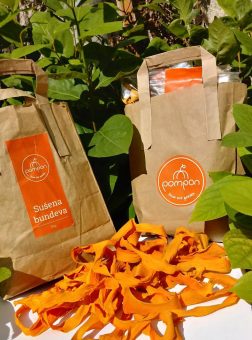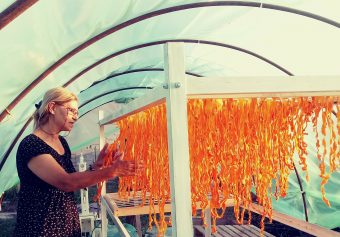Pompon sun-dried paste is designed as a healthy, gluten-free alternative to classic pasta. Fresh pumpkin, by specially designed process of cutting into strips and natural drying process on sun and air, is turned into gluten-free delicatessen paste. This project, designed by Belgradian Slavica Orelj, won the award of National Forum for Green Ideas in the category for the best innovative, environmentally oriented business projects.

The project itself is based on the idea that the contemporary way of life does not necessarily have to be contradicted to nature and environmentally conscious lifestyle. Pompon pumpkin pasta is entirely natural, high-quality food, entirely produced following ecological principles of energy efficiency, without any industrial waste and complex technological processing.
By drying pumpkin strips in the air and sun, healthy food of entirely unchanged natural composition and extremely decorative form is obtained. Due to its exotic orange colour and neutral flavour, this kind of pumpkin paste can be easily combined with various sweet and salty foods.
On the one hand, its simple preparation (it is enough to put dried strips into boiling water for 7 minutes) is adapted to the fast meals of a modern businessman, and on the other hand, its nutritious quality, the richness of taste and decorativity is recommended as exceptional delicacy worthy of top restaurants.
Exclusively muscat pumpkin that comes from the fields of local producers is used for drying. In this way, the transport of fresh pumpkin itself is reduced to the smallest possible extent. The pumpkin is cut immediately after harvesting by a special machine into long, thin strips, which are then dried naturally

in the sun and air for days until they reach the required minimum of moisture. The strips are then packed in cellophane packaging. When stored in this manner they can be used within a minimum of a year from the date of packaging. When dried in this way, pumpkin completely retains its rich natural features. Since it does not naturally contain gluten, it is suitable for special diet regimes.
A relatively short period that is suitable for natural drying is left since pumpkin matures at the end of the summer, that is why a careful and efficient organisation of all production phases is required. Only solar energy is used for the entire production process. Even the small quantity of electricity needed for the operation of cutting machines is obtained from solar panels. Only organic waste – peel and pumpkin seed – remains after the production process. In fact, the real waste doesn’t even exist. The pumpkin peel is further used to make compost – fertiliser for soil cultivation, while the seeds are dried, and they become an additional product.
Read the whole article in the new issue of the Energy portal Magazine on CIRCULAR ECONOMY, September-November 2018.



